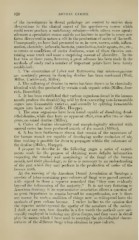Page 810 - My FlipBook
P. 810
820 : DENTAL CARIES.
of the investigators in dental pathology are content to restrict tlieir
observations to the clinical aspect of the question—a course which
could never produce a satisfactory solution—while others even openly
advocate a speculative course and do not hesitate to ascribe to every new
factor discovered in nature a role in the production of caries of the teeth.
Consequently, we have had presented to us, in turn, worms, acids, inflam-
mation, electricity, infusoria, bacteria, putrefaction, toxic agents, etc., etc.,
as causes or conditions of caries dentinuin, some of these theories con-
taining some truth and some a surprising amount of absurdity. In the
last two or three years, however, a great advance has been made in the
methods of study and a number of important points have been firmly
established
1. The observation of Leber and Rottenstein that micro-organisms
are constantly present in decaying dentine has been confirmed (Weil,
Milles, Underwood, Miller).
2. The softening of dentine in caries has been shown to be chemically
identical with that produced by certain weak organic acids (Miller, Jese-
rich, Bennefeld).
3. It has been established that various organisms found in the human
mouth produce the decalcifying acid by first converting non-fermentable
sugars into fermentable varieties, and secondly by splitting fermentable
sugars into lactic acid (Miller, Hueppe).
4. The same organisms have been found capable of dissolving decal-
cified dentine, while they have no apparent effect, even after two or three
years, on sound dentine (Miller).
5. Caries of dentine chemically and morphologically identical with
natural caries has been produced outside of the mouth (Miller).
6. It has been furthermore shown that certain of the organisms of
the human mouth are capable of developing under exclusion of air,
thus making it possible for them tg propagate within the substance of
the dentine (Miller, Hueppe).
I propose to describe in the following pages a series of experi-
ments made for the purpose of obtaining more definite information
respecting the number and morphology of the fungi of the human
mouth, and their physiology, as far as is necessary to an understanding
of the part which they may perform in the production of caries of the
human teeth.
At the meeting of the American Dental Association at Saratoga a
number of tubes containing pure cultures of fungi were passed around
;
with regard to these a reporter remarked that " they were evidently
beyond the information of the majority." It is not very flattering to
American dentistry if its representative association allows a question of
so great imjiortance to remain beyond its comprehension, nor is there
any excuse for such a condition of things now, so widespread have the
methods of jTTU'e culture become. I rather incline to the opinion that
the reporter misinterpreted the apathy of the members of the society.
I siiall, at any rate, here describe in a few words the methods now uni-
versally employed in isolating any given fungus, and then more in detail
give tlie means Avhich I have used to ascertain the physiological charac-
teristics of the different fungi when obtained in pure culture.


